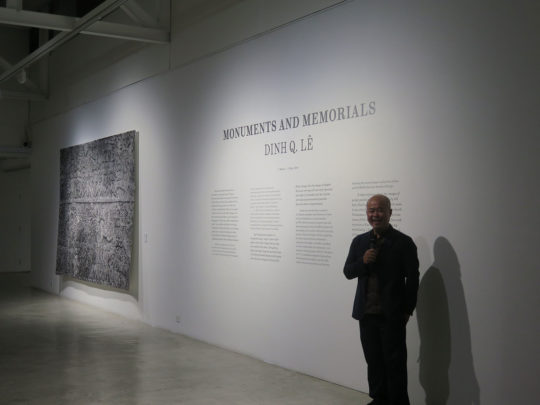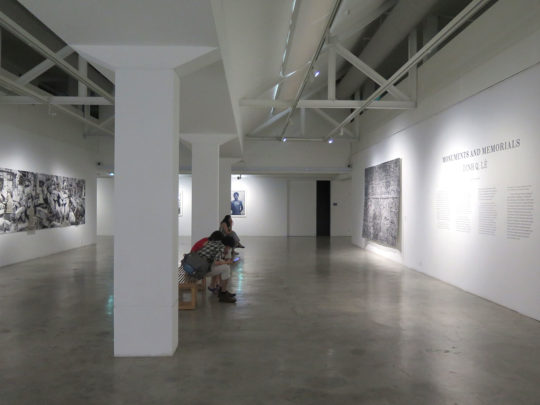Weaving Histories: Monuments and Memorials of Dinh Q. Lê
By Reaksmey Yean
Upon arrival on the second floor of STPI Creative Workshop and Gallery, visitors will be greeted by an appealing aesthetic and the graceful black and white, cobalt blue, and shimmering silver palettes of the current exhibition entitled Monuments and Memorials by an internationally successful Vietnamese-born American artist, Dinh Q. Lê [figure 1]. Together with the dimming light, the gallery space has transformed into a somewhat theatrical-like atmosphere. Featuring twenty-five pieces of interlocking shredded photographs and print is now called weaving photograph, a technique that became the artist’s signature, the show is a revisit – or a reproduction – of the artist’s earlier successful series, Cambodia: Splendor and Darkness (1994-99). These exhibiting works are created during the period of artist’s residency at STPI.
In Monuments and Memorials, the history and atrocities of the genocide of Pol Pot regime together with the visual representation of Angkorean and vernacular Khmer architectural features are being juxtaposed, formulated, materialized and projected. Yet, the exhibition attempts to explore – or to perform – the matter beyond the magnificence of Ang kor and the despondency of the genocide in a more philosophical, subtle, and contemplative manner. In the first instance, if without a prior knowledge of the artist’s ethnohistorical and autobiographical account, one might have been prompted or tricked, by virtue of the show’s artistic properties and visual conventions, into assuming that the works belong to a Cambodian native. It is fascinating, if not disturbing, to see Cambodian cultural and historical legacies being represented by a non-Cambodian artist – framing through national and ethnographica l formalities and imprint, whether or not they are genetic or imposed – and a traditional enemy of Cambodian, Vietnamese. This provokes a series of questions as to who owns the culture and who has the right to speak for the culture?
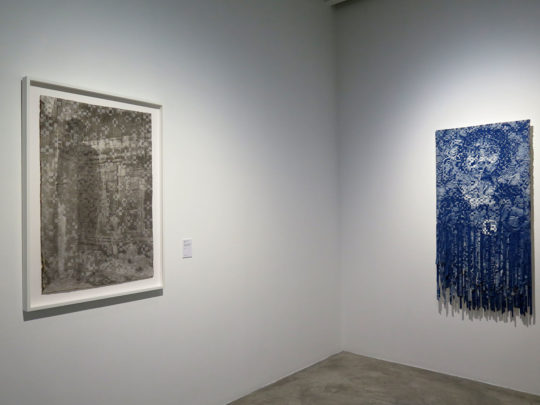
Figure 2: Dinh Q. Lê, Splendor and Darkness #29, 2017, Cyanotype on Stonehenge paper, cut, weaved and burned, 157 x 70 cm
Credit: Courtesy of the author
Over the last two decades of Lê’s artistic praxis and career, his artistic content has been oriented impressively surrounding the issues of the legacies of modern history, American-Vietnamese war, and memories – the multi-layered of narrative that has influenced his life and shaped the lives of many other individuals, yet it is not a national construction of historiography. In his artistic journey, at least two projects have centred on the Cambodian cultural and modern history, Cambodia: Splendor and Darkness, as mentioned above, and The Texture of Memory (2000-1). The latter was a project that inspired by two hundred Cambodian refugees in California, who experienced Post-traumatic Stress Disorder. It features an approximately of twenty embroidered white panels of fabric with faces of the S21 prisoners, created by lines of white thread.
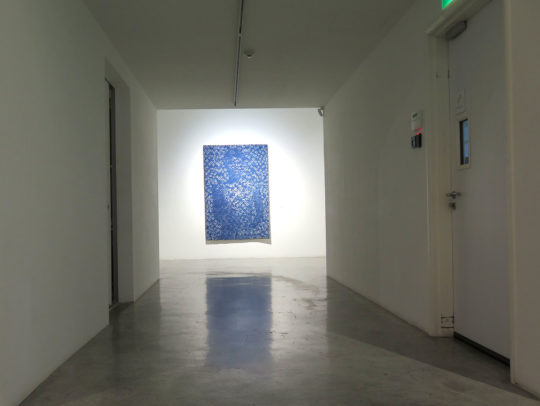
Figure 3: Dinh Q. Lê, Splendor and Darkness #27, 2017, Cyanotype on Stonehenge paper, cut, weaved and burned, 208 x140.5 cm
Credit: Courtesy of the author
The weaving photograph technique, as seen deployed within both, Monuments and Memorials and Cambodia: Splendor and Darkness, was inspired by Lê’s aunt, who practices the bamboo-mat weaving. The craft that has been characterized by many writers as “Vietnamese” tradition, as if the practice is confined strictly within a Vietnam territorialized locality, while, in fact, this tradition is seen practiced throughout mainly Southeast Asia, if not the greater Asia. In comparison, Monuments and Memorials is an experimental project in the use of media, from semi-glossy c-prints to matt paper. This is not to mention that the works are in a bigger scale, which according to the artists, this has been an artist’s desire to produce large-scale works, and the residency at STPI enables him to achieve to achieve this dream. Unfortunately, the show does not offer theviewer possibilities to see differences between the current and previous series. The exhibition makes no available references to make such a comparison possible, which catalogue from a previous show might have done the trick.
In Monuments and Memorials artworks are in various shapes, sizes, and style, including the unfinished weaving-strips that left dripping, suggesting a continuation of unfinished narrative, history in the making, seen in the example of Splendor and Darkness #29 [figure 2]. The piece depicts a woman in her short hairstyle with a prison reference number badge, appears to be standing against the backdrop of Bayon bas-relief. It is displayed on the left-hand side from the gallery’s entrance to the end of the corridor in contrast to another piece of a similar style, but with a male depiction, on the other end of the corridor. This paring is well-curated [figure 3].
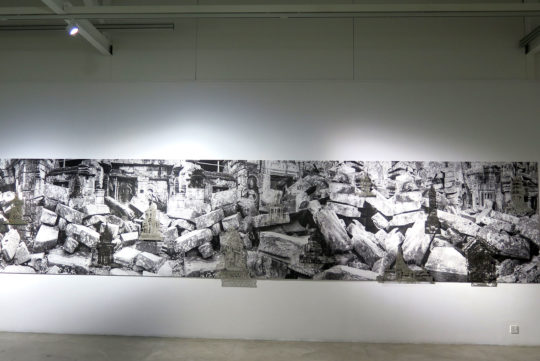
Figure 4: Dinh Q. Lê,Empire [details], 2018, Digital print on Awagami bamboo paper, laser cut acrylic and Saunders paper sculptures, 150 x1000 cm
Credit: Courtesy of the author
The exhibition’s centrepieces, however, are Empire (2018), Splendor and Darkness #32 (2017) and Adrift in Darkness (2017) [figures 4, 5, 6]. The grouping of Empire and Splendor and Darkness #32 in the central gallery, does not only permit viewer’s manoeuvrability to interact with the works, but facing them together seems to complement each other, thus creating a cohesive narrative of destruction, war, temporality, impermanence, the rotation of power, and issue of memorialization [figure 7]. In Empire, a digital print that comprised of ten interrupted-panels of 150×1000 centimetres in dimension depicts the ruin of a Khmer Prasat (temple structure) that topped on the surface by a series of Cambodian historical, political and propagandist monuments and memorial sites in a two-dimensional laser cut acrylic. While the exhibition’s catalogue is beautifully designed, the text – an essay by Charles Merewether, an authoritative curator, or the interview transcript between Tessa Tung, the exhibition curator, and the artist – does not provide details on choices of Pra sats used in the artworks, including the lack of visual references to Cambodia: Splendor and Darkness.
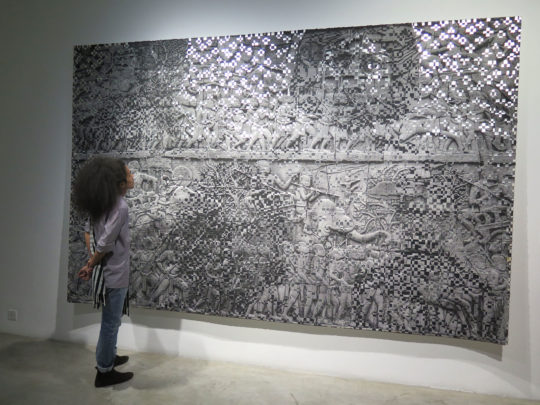
Figure 5: Dinh Q. Lê, Splendor and Darkness #32, 2017, Foiling and screen-print on Stonehenge paper, cut, weaved and burned, 221 x330 cm
Credit: Courtesy of the author
The identity of the Prasat in Empire is unknown. The iconographical coding of the Prasat’s bas-relief, however, seems to suggest that the image is a ruin of Ta Prohm, the famous temple that served as a backdrop of a Hollywood blockbuster, Lara Croft: Tomb Raider (2001). Built in a twelfth-century Bayon style, Ta Prohm was consecrated as a Buddhist monastery and learning centre. It was constructed to honour the ruler’s, Jayavarman VII’s, family. By the virtue of which, this Prasat is both a temple and a memorial site. Thus, the memorial and monument structures that modelled after the actually sites that erected all over Cambodia and are now seen mounted on top of the Ta Promh panel suggest that everything is temporary, even the great civilization and memories are subjected to the constant flux of change, if not disappearing.
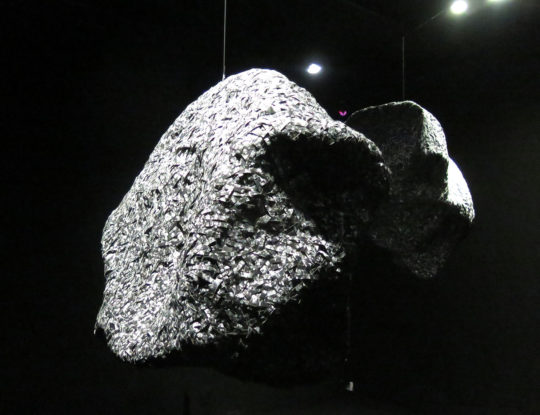
Figure 6: Dinh Q. Lê, Adrift in Darkness, 2017, Digital Print on Awagami bamboo paper, laser cut and weaved around cane structure, Dimension variable
Credit: Courtesy of the author
To the opposite side of the wall, a mat-like panel of Splendor and Darkness #32 combines a bas-relief of Bayon temple with supposedly four faces of S21 prisoners and silver foil. The four faces only became somewhat apparent when keeps a distance from the artwork. However, their abstract forms remain difficult, if it is not impossible, to identify their gender. In approaching the artwork, the faces will begin to fade into the background, and the shimmering of interweaved silver foils create pixelate effects, foregrounding the base-relief. Here is a scene, where Jayavarman VII’s military are in procession, probably a troupe that was sent to subdue the Champa, ancient civilization that is in today Vietnam. The artist’s use of silver is inspired by the Buddhist tradition of applying gold-leaf onto venerated objects and by the silver tiles of Silver Pagoda’s floor in Phnom Penh’s royal palace. This piece reminds viewer that either memory or history are the abstract, multi-layered, and are at once present and absent.
And to the back of the gallery, in a dark room that takes the eyes a while to adjust to its low light, three stone-like weaving photographs in various sizes are suspended from the ceiling – the first-ever three-dimensional works by the artist. The room’s darkness seems to imitate the sanctum sanctorum of a Hindu temple, and in our case, the gallery temple. Here viewer is invited to approach the temple most sacred object in a quiet manner [figure 6]. A closer inspection allows viewer to see, in form of a photo-montage, images from recent refugee exodus from Africa and the Middle East into Southern Europe, and the Khmer Rouge genocide. This installation is itself a memorial site to modern tragedy of humanity [figure 8].

Figure 8: Dinh Q. Lê, Adrift in Darkness [Details], 2017, Digital Print on Awagami bamboo paper, laser cut and weaved around cane structure, Dimension variable
Credit: Courtesy of the author
The exhibition, according to STPI’s website, marks the premiere of Cambodia: Splendor and Darkness in Asia, which has always been the artist’s intention to present this work in the region.
Whether or not it is a coincidence, the premier seems to be in a beautiful complement with the currently inaugurated exhibition, Angkor, Exploring the Cambodia’s Sacred City , by Asian Civilisation Museum in collaboration with Musée Guimet in Paris.
However, the nationalist would continue to demand an answer to the question as to whether a Vietnamese has the right to represent Cambodian cultural and historical heritage. It is worth noting that Lê was born in Hà Tiên, a town adjacent to Cambodian border in 1968, a period of the Second Indochina War. Lê left his birth country under circumstances of extreme political unrest and violence in 1978, when Vietnamese troops invaded Cambodia, partly in response to the Khmer Rouge’s incursions of theVietnamese border, including Hà Tiên. The historical records inform that more than 3000 Vietnamese were killed by the Khmer Rouge. Lê eventually migrated with his family to the US, where he received his artistic education. This historical connection allows us to see Lê’s intimate relationship to the Khmer Rouge and thus to Cambodian modern history. The works of Lê is a reminder that history does not belong to a nation marked by modern boundaries but to a larger history of humanity. This question of cultural identity is, admittedly, not easy to resolve given that Lê’s artworks themselves are multi-layered.
The exhibition ran from 17th March to 12th May 2018 at the Singapore Tyler Print Institute.


